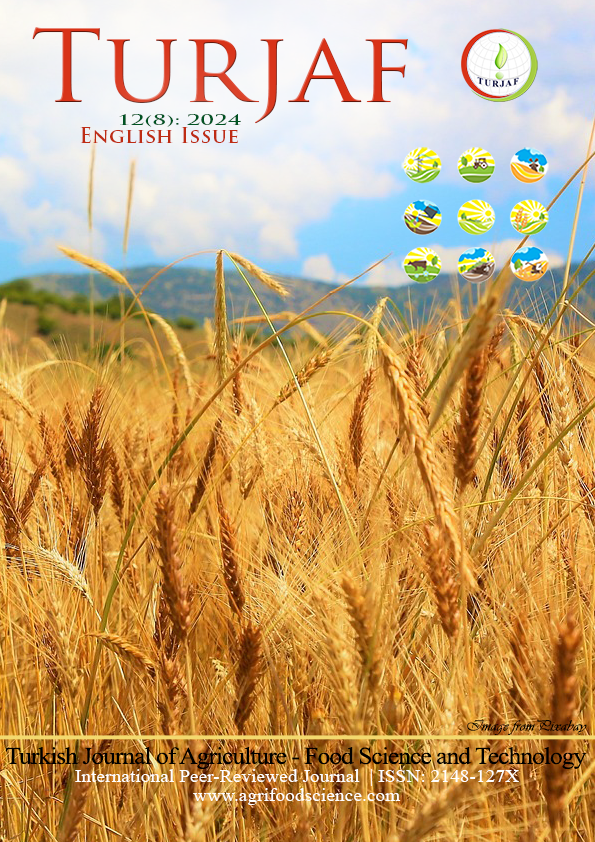The Separation of Free Bran by Using Electricity-Assisted Electrostatic Field System
DOI:
https://doi.org/10.24925/turjaf.v12i8.1396-1401.6968Keywords:
bulgur, bran, electrostatic separation, electric field, PVCAbstract
In this study, it was to identify a method for separating the free bulgur bran from the fine bulgur during the production of bulgur. This was attempted by creating an electrostatic field using a PVC surface. It was observed that the issue of free bran, which adversely affects the packaged products visually, was effectively solved by this method. In contrast to conventional techniques, an alternative methodology was employed which utilizing a device comprising a folded PVC surface (folded curved channel). The configuration of the experimental apparatus was developed with dimensions of 4, 5 and 6 cm in width, 20, 40 and 60 cm in length, and angles of 30, 35 and 40 degrees, respectively. At the end of the PVC surface, plates were placed to create an electric field. In order to create the electric field, one of the plates was charged with a positive and the other with a negative charge. The distance between the plates was varied according to the width of the tunnel. The expected results were obtained in the layered PVC system. Consequently, a fine bulgur mixture consisting of 5 g of bran per 1000 g of bulgur was introduced into the experimental system at a flow rate of 0.89 g/s. This resulted in a notable reduction in the free bran content, which decreased from 5 g to approximately 2 g.
References
AOAC. (1990). Official Methods of Analysis, Fıfteenth Ed. Association of Official Analytical Chemists, Washington DC, USA.
Andrady, A. L. and Neal, M. A. (2009). Applications and societal benefits of plastics. Philosophical Transactions of the Royal Society B: Biological Sciences, 364(1526), 1977-1984. https://doi.org/10.1098/rstb.2008.0304
Amir, R.M., Anjum, F.M., Khan, M.I., Khan, M.R., Pasha, I., Nadeem, M. (2013). Application of Fourier transform infrared (FTIR) spectroscopy for the identification of wheat varieties. J. Food Sci. Technol. 50 (5), 1018–1023.
Bébin, P., Mavrovic, D., & Rochette, A. (2014). Electrostatic separation as a characterizing tool for the insulation of conductive mineral particles. Journal of Minerals and Materials
Berthomieu, C., & Hienerwadel, R. (2009). Fourier transform infrared (FTIR) spectroscopy. Photosynthesis Research, 101, 157-170.
Bledzki, A.K., Mamun, A.A., Volk, J. (2010). Physical, chemical and surface properties of wheat husk, rye husk and soft wood and their polypropylene composites. Composites Part A 41, 480–488.
Electrostatic accelerators. Engines of Discovery, 1-9. (2014). https://doi.org/10.1142/9789814417204_0001
Ege, M. B., Font, A., Bolat, S., & Kalenderli, O. (2014, September). Design principles and performance analysis of a wimshurst generator. In 2014 ICHVE International Conference on High Voltage Engineering and Application (pp. 1-5). IEEE.
Fitzpatrick, R. (2010). Maxwells equations and the principles of electromagnetism. Laxmi Publications, Ltd..
Göksu, A., Omac, B., & Sabancı, S. (2022). Ohmic heating: a futuristic method for cooking bulgur. Journal of Food Processing and Preservation, 46(11). https://doi.org/10.1111/jfpp.17025
Kayıran, S. N., & Bayram, M. (2024). Separation of Bran from Bulgur through Tribocharging with Teflon. Journal of Cereal Science, 103976.
Lee, S., Castro, E. R., Guijt, R. M., Tarn, M. D., & Manz, A. (2017). Van de graaff generator for capillary electrophoresis. Journal of Chromatography A, 1517, 195-202. https://doi.org/10.1016/j.chroma.2017.08.026
Michel, S., & Bayram, M. (2024). Influence of cooking water hardness on the chemical, colour and textural characteristics of bulgur at different processing stages. Journal of Cereal Science, 115, 103826.
Miura, M., Fukuma, M., & Kishida, S. (2014). Electrical breakdown and space charge formation at high‐temperature region in long‐time heating treatment pvc. Electrical Engineering in Japan, 188(2), 18-28. https://doi.org/10.1002/eej.22528
Rybarczyk, D., Jędryczka, C., Regulski, R., Sędziak, D., Netter, K., Czarnecka‐Komorowska, D & Barański, M. (2020). Assessment of the electrostatic separation effectiveness of plastic waste using a vision system. Sensors, 20(24), 7201. https://doi.org/10.3390/s20247201
Tekin, M., Babacan, Ü., Batu, O., Akar, T., & Cengiz, M. F. (2021). The effects of genotypic variation in hulled wheat species and cooking methods on some quality parameters of bulgur. Journal of Food Processing and Preservation, 46(6). https://doi.org/10.1111/jfpp.15979
Thabet, A. and Fouad, M. (2024). Experimental and simulation analysis for insulation deterioration and partial discharge currents in nanocomposites of power cables. International Journal of Electrical and Computer Engineering (IJECE), 14(2), 1194. https://doi.org/10.11591/ijece.v14i2.pp1194-1202
Yağcı, S., Kocabaş, D. S., Çalışkan, R., & Özbek, H. N. (2022). Statistical investigation of the bioprocess conditions of alkali combined twin‐screw extrusion pretreatment to enhance fractionation and enzymatic hydrolysis of bulgur bran. Journal of the Science of Food and Agriculture, 102(11), 4770-4779. https://doi.org/10.1002/jsfa.11837
Yilmaz, V. A. (2020). Effects of several production methods on technological, textural and sensorial properties of emmer (Triticum turgidum ssp. dicoccum) bulgur. Journal of Food Science and Technology, 57, 3874-3883.
Yousif, S. Ibrahim, Bayram, M., Kesen, S. (2018). Characterization of Volatile Compounds of Bulgur (Antep Type) Produced from Durum Wheat. Journal of Food Quality, Article ID 8564086, 9 pages.
Zhu, H., Bai, Y., Zu, L., Bi, H., Wen, J. (2023). Separation of metal and cathode materials from waste lithium iron phosphate battery by electrostatic process. Separations. 10(3), 220. https://doi.org/10.3390/separations10030220
Downloads
Published
How to Cite
Issue
Section
License
This work is licensed under a Creative Commons Attribution-NonCommercial 4.0 International License.

























